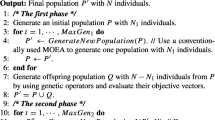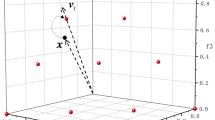Abstract
During recent decades, multi-objective optimization has aroused extensive attention, and a variety of related algorithms have been proposed. A hybrid multi-objective optimization algorithm based on angle competition and neighborhood protection mechanism (HCPMOEA) is proposed in this paper. First, an environmental selection strategy based on neighborhood protection is introduced to make great compromises between optimization performance and time consumption. Then, the difference between Genetic algorithm and Differential evolution is analyzed from the perspective of offspring distribution and a hybrid operator is proposed to obtain good balances between exploration and exploitation. Besides, an elite set is employed to improve chances of the superior solutions generating offspring, and angle competition strategy is adopted to realize optimization matching of parents, thus improving the quality of offspring. The performance of HCPMOEA has been proved by comparing with 13 classic or state-of-the-arts algorithms on 19 standard benchmark, and the corresponding results show the competitive advantages in effectiveness and efficiency. In addition, the practicality of the proposed HCPMOEA is further verified by two real-world instances. Therefore, all of the aforementioned results have proved the superiority of the proposed HCPMOEA in solving bi-objective and tri-objective problems.

















Similar content being viewed by others
Explore related subjects
Discover the latest articles, news and stories from top researchers in related subjects.References
Mirjalili S, Jangir P, Mirjalili SZ , Saremi S, Trivedi IN (2017) Optimization of problems with multiple objectives using the multi-verse optimization algorithm. Knowl-Based Syst 134:50–71
Zeng N, Song D, Li H, You Y, Liu Y, Alsaadi FE (2021) A competitive mechanism integrated multi-objective whale optimization algorithm with differential evolution. Neurocomputing 432:170–182
Bader J, Zitzler E (2011) Hype: an algorithm for fast hypervolume-based many-objective optimization. Evol Comput 19(1):45–76
Bai J, Liu H (2016) Multi-objective artificial bee algorithm based on decomposition by pbi method. Appl Intell 45(4):976–991
Said LB, Bechikh S, Ghedira K (2010) The r-dominance: a new dominance relation for interactive evolutionary multicriteria decision making. IEEE Trans Evol Comput 14(5):801–818
Cervantes-Salido VM, Jaime O, Brizuela CA, Martínez-Pérez IM (2013) Improving the design of sequences for dna computing: a multiobjective evolutionary approach. Appl Soft Comput 13(12):4594–4607
Chai R, Al S, Tsourdos A, Xia Y, Chai S (2020) Solving multiobjective constrained trajectory optimization problem by an extended evolutionary algorithm. IEEE Trans Cybern 50(4):1630–1643
Chen H, Cheng R, Wen J, Li H, Weng J (2020) Solving large-scale many-objective optimization problems by covariance matrix adaptation evolution strategy with scalable small subpopulations. Inf Sci 509:457–469
Chen H, Tian Y, Pedrycz W, Wu G, Wang R, Wang L (2020) Hyperplane assisted evolutionary algorithm for many-objective optimization problems. IEEE Trans Cybern 50(7):3367–3380
Cheng R, Jin Y, Narukawa K, Sendhoff B (2015) A multiobjective evolutionary algorithm using gaussian process-based inverse modeling. IEEE Trans Evol Comput 19(6):838–856
Cheng R, Jin Y, Olhofer M, Sendhoff B (2016) A reference vector guided evolutionary algorithm for many-objective optimization. IEEE Trans Evol Comput 20(5):773–791
Chugh T, Jin Y, Miettinen K, Hakanen J, Sindhya K (2018) A surrogate-assisted reference vector guided evolutionary algorithm for computationally expensive many-objective optimization. IEEE Trans Evol Comput 22(1):129–142
Coello CAC, Pulido GT, Lechuga MS (2004) Handling multiple objectives with particle swarm optimization. IEEE Trans Evol Comput 8(3):256–279
Coello CA, Lamont GB, Van Veldhuizen DA, et al. (2007) Evolutionary algorithms for solving multi-objective problems, vol 5
Dai C, Wang Y, Ye M (2015) A new multi-objective particle swarm optimization algorithm based on decomposition. Inf Sci 325:541–557
Deb K, Pratap A, Agarwal S, Meyarivan T (2002) A fast and elitist multiobjective genetic algorithm: Nsga-ii. IEEE Trans Evol Comput 6(2):182–197
Deb K, Jain H (2014) An evolutionary many-objective optimization algorithm using reference-point-based nondominated sorting approach, part i: Solving problems with box constraints. IEEE Trans Evol Comput 18(4):577–601
Deb K, Thiele L, Laumanns M, Zitzler E (2005) Scalable test problems for evolutionary multiobjective optimization. In: Evolutionary multiobjective optimization. Springer, London, pp 105–145
Fan Z, Li W, Cai X, Li H, Wei C, Zhang Q, Deb K, Goodman E (2019) Push and pull search for solving constrained multi-objective optimization problems. Swarm Evol Comput 44:665–679
Fonseca CM, Fleming PJ, et al. (1993) Genetic algorithms for multiobjective optimization: formulationdiscussion and generalization. In: Icga, vol 93. Citeseer, pp 416–423
Guo D, Wang X, Gao K, Jin Y, Ding J, Chai T (2022) Evolutionary optimization of high-dimensional multiobjective and many-objective expensive problems assisted by a dropout neural network. IEEE Trans Syst Man Cybern Syst 52(4):2084–2097
Han F, Chen W, Ling Q, Han H (2021) Multi-objective particle swarm optimization with adaptive strategies for feature selection. Swarm Evol Comput 62:100847
Hua Y, Jin Y, Hao K (2019) A clustering-based adaptive evolutionary algorithm for multiobjective optimization with irregular pareto fronts. IEEE Trans Cybern 49(7):2758–2770
Ishibuchi H, Tsukamoto N, Nojima Yusuke (2008) Evolutionary many-objective optimization: a short review. In: 2008 IEEE congress on evolutionary computation (IEEE world congress on computational intelligence), pp 2419–2426
Jain H, Deb K (2014) An evolutionary many-objective optimization algorithm using reference-point based nondominated sorting approach, part ii: handling constraints and extending to an adaptive approach. IEEE Trans Evol Comput 18(4):602–622
Jiang S, Yang S (2017) A strength pareto evolutionary algorithm based on reference direction for multiobjective and many-objective optimization. IEEE Trans Evol Comput 21(3):329– 346
Kukkonen S, Lampinen J (2005) Gde3: the third evolution step of generalized differential evolution. In: 2005 IEEE congress on evolutionary computation, vol 1, pp 443–450
Li H, Song B, Tang X, Xie Y, Zhou X (2021) A multi-objective bat algorithm with a novel competitive mechanism and its application in controller tuning. Eng Appl Artif Intell 106:104453
Li H, Zhang Q (2009) Multiobjective optimization problems with complicated pareto sets, moea/d and nsga-ii. IEEE Trans Evol Comput 13(2):284–302
Li H, Zhang Q, Deng J (2016) Biased multiobjective optimization and decomposition algorithm. IEEE Trans Cybern 47(1):52–66
Li K, Chen R, Fu G, Yao X (2019) Two-archive evolutionary algorithm for constrained multiobjective optimization. IEEE Trans Evol Comput 23(2):303–315
Li M, Yang S, Liu X (2015) Bi-goal evolution for many-objective optimization problems. Artif Intell 228:45–65
Li M, Yang S, Liu X (2016) Pareto or non-pareto: bi-criterion evolution in multiobjective optimization. IEEE Trans Evol Comput 20(5):645–665
Li W, Zhang T, Wang R, Ishibuchi H (2021) Weighted indicator-based evolutionary algorithm for multimodal multi-objective optimization. IEEE Trans Evol Comput 25(6):1064–1078
Liang Z, Hu K, Ma X, Zhu Z (2021) A many-objective evolutionary algorithm based on a two-round selection strategy. IEEE Trans Cybern 51(3):1417–1429
Phan DH, Suzuki J (2013) R2-ibea: r2 indicator based evolutionary algorithm for multiobjective optimization. In: 2013 IEEE congress on evolutionary computation, pp 1836–1845
Ponsich A, Domenech B, Ferrer-Martí L, Juanpera M, Pastor R (2022) A multi-objective optimization approach for the design of stand-alone electrification systems based on renewable energies. Expert Syst Appl 199:116939
Qi Y, Ma X, Liu F, Jiao L, Sun J, Jianshe W (2014) Moea/d with adaptive weight adjustment. Evol Comput 22(2):231–264
Teng X, Liu J, Li M (2021) Overlapping community detection in directed and undirected attributed networks using a multiobjective evolutionary algorithm. IEEE Trans Cybern 51(1):138– 150
Tian Y, Cheng R, Zhang X, Jin Y (2017) Platemo: a matlab platform for evolutionary multi-objective optimization [educational forum]. IEEE Comput Intell Mag 12(4):73–87
Tian Y, Cheng R, Zhang X, Cheng F, Jin Y (2018) An indicator-based multiobjective evolutionary algorithm with reference point adaptation for better versatility. IEEE Trans Evol Comput 22(4):609–622
Tian Y, Cheng R, Zhang X, Su Y, Jin Y (2019) A strengthened dominance relation considering convergence and diversity for evolutionary many-objective optimization. IEEE Trans Evol Comput 23 (2):331–345
Tian Y, He C, Cheng R, Zhang X (2021) A multistage evolutionary algorithm for better diversity preservation in multiobjective optimization. IEEE Trans Syst Man Cybern Syst 51(9):5880– 5894
Tian Y, Zhang X, Cheng R, He C, Jin Y (2020) Guiding evolutionary multiobjective optimization with generic front modeling. IEEE Trans Cybern 50(3):1106–1119
Tian Y, Zhang X, Wang C, Jin Y (2020) An evolutionary algorithm for large-scale sparse multiobjective optimization problems. IEEE Trans Evol Comput 24(2):380–393
Tian Y, Zheng X, Zhang X, Jin Y (2020) Efficient large-scale multiobjective optimization based on a competitive swarm optimizer. IEEE Trans Cybern 50(8):3696–3708
Wang F, Li Y, Liao F, Yan H (2020) An ensemble learning based prediction strategy for dynamic multi-objective optimization. Appl Soft Comput 96:106592
Wang H, Jiao L, Yao X (2015) Two-arch2: an improved two-archive algorithm for many-objective optimization. IEEE Trans Evol Comput 19(4):524–541
Wang R, Purshouse RC, Fleming PJ (2013) Preference-inspired coevolutionary algorithms for many-objective optimization. IEEE Trans Evol Comput 17(4):474–494
Yang S, Li M, Liu X, Zheng J (2013) A grid-based evolutionary algorithm for many-objective optimization. IEEE Trans Evol Comput 17(5):721–736
Yuan Y, Xu H, Wang B (2015) An experimental investigation of variation operators in reference-point based many-objective optimization. In: Proceedings of the 2015 annual conference on genetic and evolutionary computation, pp 775–782
Zhang K, Shen C, Liu X, Yen GG (2020) Multiobjective evolution strategy for dynamic multiobjective optimization. IEEE Trans Evol Comput 24(5):974–988
Zhang K, Xu Z, Xie S, Yen GG (2021) Evolution strategy-based many-objective evolutionary algorithm through vector equilibrium. IEEE Trans Cybern 51(11):5455–5467
Zhang Q, Li H (2007) Moea/d: a multiobjective evolutionary algorithm based on decomposition. IEEE Trans Evol Comput 11(6):712–731
Zhang X, Tian Y, Jin Y (2015) A knee point-driven evolutionary algorithm for many-objective optimization. IEEE Trans Evol Comput 19(6):761–776
Zhang X, Zheng X, Cheng R, Qiu J, Jin Y (2018) A competitive mechanism based multi-objective particle swarm optimizer with fast convergence. Inf Sci 427:63–76
Zhou A, Qu B, Li Hui, Zhao S, Suganthan PN, Zhang Q (2011) Multiobjective evolutionary algorithms: a survey of the state of the art. Swarm Evol Comput 1(1):32–49
Zhu C, Xu L, Goodman ED (2016) Generalization of pareto-optimality for many-objective evolutionary optimization. IEEE Trans Evol Comput 20(2):299–315
Zhu Z, Zhou X (2021) A multi-objective multi-micro-swarm leadership hierarchy-based optimizer for uncertain flexible job shop scheduling problem with job precedence constraints. Expert Syst Appl 182:115214
Zitzler E, Deb K, Thiele L (2000) Comparison of multiobjective evolutionary algorithms: empirical results. Evol Comput 8(2):173–195
Zitzler E, Künzli S (2004) Indicator-based selection in multiobjective search. In: International conference on parallel problem solving from nature. Springer, pp 832–842
Zitzler E, Laumanns M, Thiele L (2001) Spea2: improving the strength pareto evolutionary algorithm. TIK-report, vol 103
Zou X, Chen Y, Liu M, Kang L (2008) A new evolutionary algorithm for solving many-objective optimization problems. IEEE Trans Syst Man Cybern Part B Cybern 38(5):1402–1412
Acknowledgements
This work is supported by the National Natural Science Foundation of China (Grants NO. 51774219), Key Research and Development Projects of Hubei Province (Grants NO. 2020BAB098) and Science and Technology project of Hubei Province (Grants NO. 2020BED003).
Author information
Authors and Affiliations
Contributions
Yang Li and Weigang Li contributed the central idea for the study, developed software and wrote the original draft; Yuntao Zhao and Songtao Li contributed to refining the ideas, collating and analysing results; all authors discussed the results and revised the manuscript.
Corresponding author
Ethics declarations
Conflict of Interests
The authors declare that they have no known competing financial interests or personal relationships that could have appeared to influence the work reported in this paper.
Additional information
Publisher’s note
Springer Nature remains neutral with regard to jurisdictional claims in published maps and institutional affiliations.
Rights and permissions
About this article
Cite this article
Li, Y., Li, W., Zhao, Y. et al. Hybrid multi-objective optimization algorithm based on angle competition and neighborhood protection mechanism. Appl Intell 53, 9598–9620 (2023). https://doi.org/10.1007/s10489-022-03920-7
Accepted:
Published:
Issue Date:
DOI: https://doi.org/10.1007/s10489-022-03920-7




